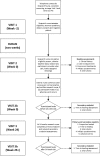Wool-derived keratin dressings versus usual care dressings for treatment of slow-healing venous leg ulceration: study protocol for a randomised controlled trial (Keratin4VLU)
- PMID: 29440219
- PMCID: PMC5829898
- DOI: 10.1136/bmjopen-2017-020319
Wool-derived keratin dressings versus usual care dressings for treatment of slow-healing venous leg ulceration: study protocol for a randomised controlled trial (Keratin4VLU)
Abstract
Introduction: Keratins, filament-forming proteins found in vertebrate epithelium, are downregulated in slow-healing venous leg ulcers (VLU) compared with normal-healing VLU. Laboratory and animal model research has suggested exogenous keratins increase expression of endogenous keratins. A non-randomised controlled trial of an exogenous keratin dressing reported increased healing in slow-healing VLU. To date, no randomised controlled trial has been done to verify these promising findings.
Methods and analysis: The Keratin4VLU trial is a single-blind, pragmatic, parallel group, randomised controlled trial of keratin dressings compared with usual care non-medicated dressings in patients with VLU where either (1) the ulcer area is greater than 5 cm2, (2) the ulcer has been present for more than 26 weeks or (3) both. All patients will receive compression therapy. The primary outcome is the proportion of patients with healed VLU at 24 weeks after randomisation as adjudicated by blinded review of an ulcer photograph. Secondary outcomes are time to healing, estimated change in ulcer area, change in health-related quality of life, agreement between blinded and unblinded assessors and adverse events. The analysis will be intention-to-treat on the primary and secondary outcomes (excepting health-related quality of life).
Ethics and dissemination: The Keratin4VLU trial received ethical approval from the Northern A Health and Disability Ethics Committee. We plan to publish the results within 1 year of trial completion and will include the results on the trial registration page.
Trial registration number: NCT02896725; Pre-results.
Keywords: bandages and dressings; keratin; skin substitutes; venous leg ulcer; wound healing.
© Article author(s) (or their employer(s) unless otherwise stated in the text of the article) 2018. All rights reserved. No commercial use is permitted unless otherwise expressly granted.
Conflict of interest statement
Competing interests: None declared.
Figures
References
-
- Ashby RL, Gabe R, Ali S, et al. . VenUS IV (Venous leg Ulcer Study IV) - compression hosiery compared with compression bandaging in the treatment of venous leg ulcers: a randomised controlled trial, mixed-treatment comparison and decision-analytic model. Health Technol Assess 2014;18:1–294. 10.3310/hta18570 - DOI - PMC - PubMed
Publication types
MeSH terms
Substances
Associated data
LinkOut - more resources
Full Text Sources
Other Literature Sources
Medical

